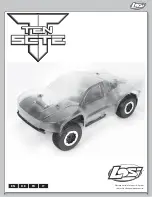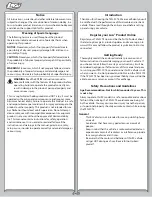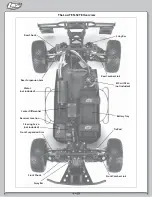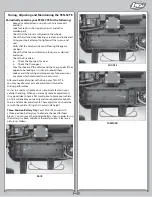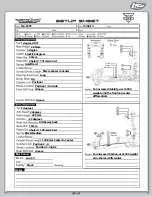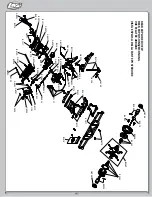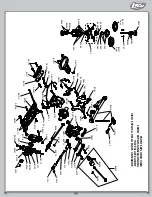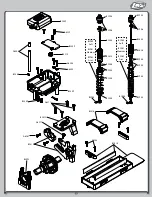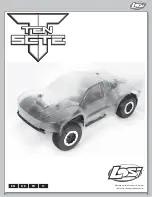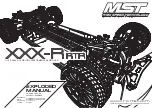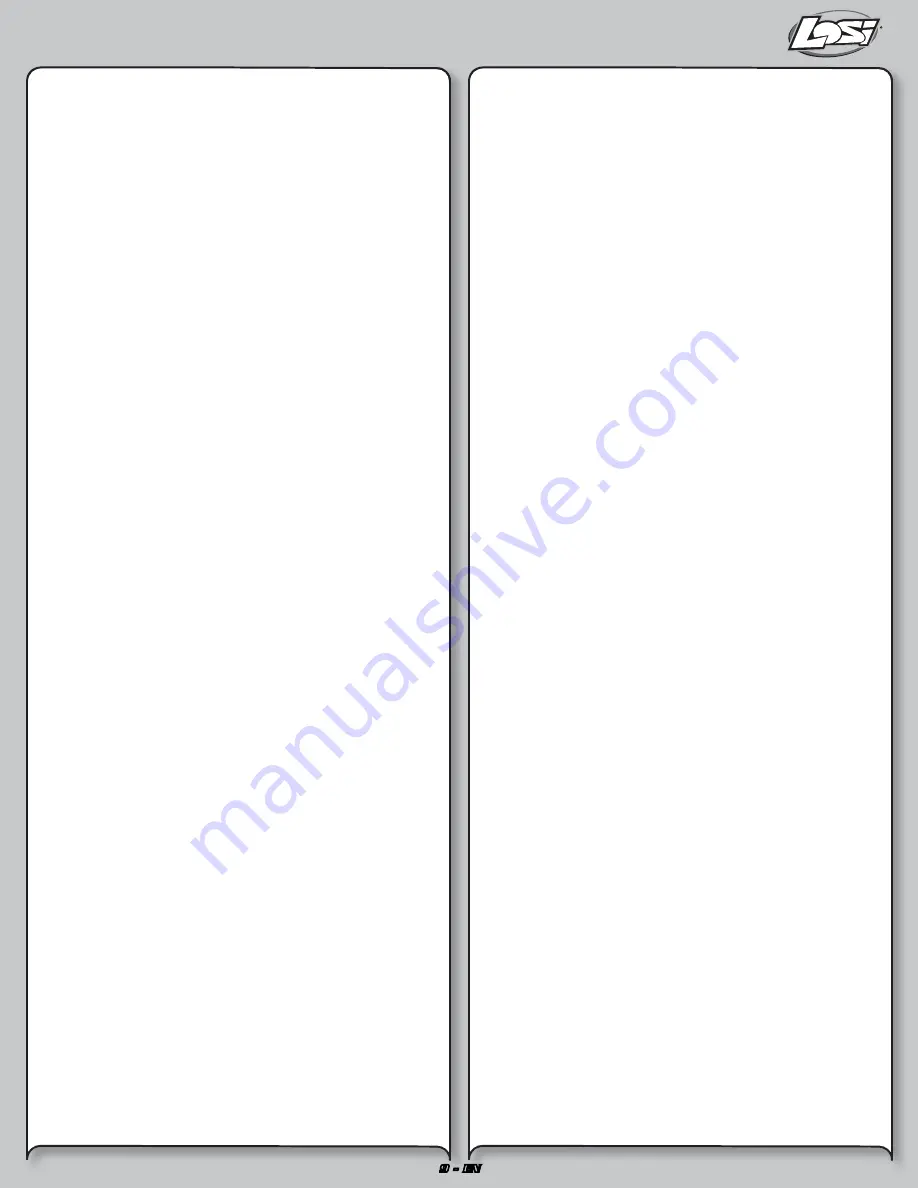
9 - EN
9 -
E
9 -
E
EN
N
EN
N
Tuning the Rear End of the TEN-SCTE
Shock Location
: Moving the shocks out on the arm will result
in less forward traction and let the TEN-SCTE make more of
an arc through the exit of the turn. In general, when changing
shock locations on the arm, it will be necessary to go down one
spring rate when moving out on the arm.
Static Camber
: Having the same defi nition as for the front end
and measured in the same fashion, rear camber can also be a
critical tuning feature. Testing has shown that running a small
amount of negative camber (.5-1 degree) is best. Increasing
negative rear camber (in the range of 1.5-3 degrees) will
increase stability and traction in corners, but decrease high-
speed stability. Decreasing rear camber (in the range of 0-1.5
degrees) will decrease stability and traction in corners, but will
increase high-speed stability.
Inboard Camber Location
: The TEN-SCTE has two inner
camber link locations. These locations work in the same
fashion and have the same eff ect as noted for the front. You
will fi nd that you will get more noticeable changes with the
outer locations in the hub. In general the upper hole will make
the TEN-SCTE more stable and keep the front end fl atter. This
works well on higher traction surfaces. The lower location will
make the steering more aggressive which works well on lower
traction surfaces. This can be good in some conditions but can
also make the TEN-SCTE diffi
cult to drive in others.
Outboard Camber Location
: Running the camber link in the
inside position on the hub will generate more rotation entering
a turn, but decrease steering on exit. Running the camber link
in the furthest outer position on the hub will generate more
stability entering a turn and increase steering on exit.
Toe-In
: Having the same defi nition as for the front end, the
toe-in can be adjusted on the TEN-SCTE with the rear hubs. The
stock toe-in is 3 degrees of inboard per side and 0 degrees in
the hub. Increasing rear toe-in will increase forward traction
and initial steering, but reduce straightaway speed. Decreasing
rear toe-in will decrease forward traction and “free-up” the TEN-
SCTE. Less toe-in can be used to gain top speed.
Ride Height
: This is the height of the chassis in relation to the
surface. It is an adjustment that aff ects the way your TEN-
SCTE jumps, turns and goes through bumps. To check the
ride height, drop one end (front or rear) of the TEN-SCTE from
about a 5 to 6-inch height onto a fl at surface. Once the TEN-
SCTE settles into a position, check the height of that end of the
TEN-SCTE in relationship to the surface. To raise the ride height,
lower the shock adjuster nuts on the shock evenly on the end
(front or rear) of the TEN-SCTE that you are working on. To lower
the ride height, raise the shock adjuster nuts. Both left and right
nuts should be adjusted evenly. Check the setup sheet included
and for additional setup information visit www.losi.com.
I
nboard Camber Location
: The TEN-SCTE has two diff erent
inner locations with vertical adjustment for the front camber
tie rod. In general, the lower or further out the inside position
is, relative to the outside, the more camber gain (total camber
change through the total throw of the suspension) is present.
This is an adjustment that is diffi
cult to make a generic
statement as it can have slightly diff erent results in various
conditions. The following is a summary of how this adjustment
will usually impact the handling of the TEN-SCTE. A longer front
camber link will usually make the TEN-SCTE feel stiff er. This will
help keep the TEN-SCTE fl atter with less roll, but can make the
TEN-SCTE handle worse in bumpy conditions. It also will make
the TEN-SCTE easier to drive. A shorter front camber link will
result in more front end roll, which will provide more steering
on tighter turns with the loss of some stability. You will also lose
some high-speed steering but might gain some more steering
response. Too short of a front link may make the TEN-SCTE feel
“twitchy” or “wandery” meaning that it may be diffi
cult to drive
straight at high speed.
Toe-In
/
Out
: This is the parallel relationship of the front tires to
one another. Toe-in/out adjustments are made by changing the
overall length of the steering tie rods. Toe-in (the front of the
tires point inward, to a point in front of the front axle) will make
the TEN-SCTE react a little slower, but have more steering from
the middle of the turn, out. The opposite is true with toe-out
(the front of the tires point outward, coming to a point behind
the front axle), the TEN-SCTE will turn into the corner better but
with a decrease in steering from the middle of the turn, out.
Toe-in will help the TEN-SCTE to “track” better on long straight
high-speed runs, where toe-out has a tendency to make the
TEN-SCTE wander. We recommend to run between 0-degree of
toe-in/out to 1 degree of toe-in.
Diff erentials
: The TEN-SCTE comes equipped with grease
in all three diff erentials. You can switch to oil. Thinner front
oil increases off -power steering, but if the oil is too thin the
steering will become grabby and inconsistent. Thicker front
diff erential oil increases off -power stability and increases on-
power steering. Thinner center diff erential has less forward
drive, can unload more under acceleration and is easier to drive
on rough and slick tracks. Thicker center diff erential has more
acceleration, increases on-power steering, and less off -power
steering. Thinner rear diff erential has more cornering traction
and increases steering in the middle of the turn. Thicker rear
diff erential has less steering in the middle of the turn and more
forward traction.
Summary of Contents for TEN-SCTE
Page 1: ...Not responsible for errors All prices subject to change without notice EN DE FR IT ...
Page 20: ...62 62 62 62 62 62 62 62 62 A6264 B2421 A6240 A6315 B7109 B7018 A6258 A7215 ...
Page 22: ...Not responsible for errors All prices subject to change without notice EN DE FR IT ...
Page 41: ...62 62 62 62 62 62 62 62 62 A6264 B2421 A6240 A6315 B7109 B7018 A6258 A7215 ...
Page 43: ...Not responsible for errors All prices subject to change without notice EN DE FR IT ...
Page 62: ...62 62 62 62 62 62 62 62 62 A6264 B2421 A6240 A6315 B7109 B7018 A6258 A7215 ...
Page 64: ...Not responsible for errors All prices subject to change without notice EN DE FR IT ...
Page 83: ...62 62 62 62 62 62 62 62 62 A6264 B2421 A6240 A6315 B7109 B7018 A6258 A7215 ...

